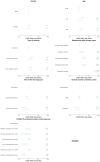Associated factors in SARS-CoV-2 infection among close contacts during the zero-COVID policy from 2020 to 2022 in the northeast of Shenzhen, China: a retrospective cohort study
- PMID: 40567988
- PMCID: PMC12187859
- DOI: 10.3389/fpubh.2025.1589683
Associated factors in SARS-CoV-2 infection among close contacts during the zero-COVID policy from 2020 to 2022 in the northeast of Shenzhen, China: a retrospective cohort study
Abstract
Background: Identifying high-risk groups and developing specific interventions is essential to combat pandemic including COVID-19. We estimated key factors of demographic characteristic, exposure-related variables, and vaccination status in secondary infection among close contacts throughout the zero-COVID policy.
Methods: We used contact tracing data from 622 primary cases and 31,278 close contacts between February 2020 and December 2022 in the northeast of Shenzhen, China. The multivariate logistic regression was utilized to identify factors affecting SARS-CoV-2 infection of close contacts.
Results: The secondary attack rate (SAR) of close contacts was 1.4% (95% CI: 1.3-1.5%), and the associated factors included over 50 (OR = 1.47, 95% CI: 1.13-1.91), living in urban village housing (OR = 1.51, 95% CI: 1.04-2.19), closer relationship with primary cases (e.g., household members: OR = 44.06, 95% CI: 34.45-56.36), last exposure occurring before the illness onset of cases (e.g., >2 days before: OR = 0.52, 95% CI: 0.27-1.00), exposed to cases with moderate symptoms (OR = 0.62, 95% CI: 0.40-0.95), and better COVID-19 vaccination status (e.g., booster vaccination within 6 months before the last exposure: OR = 0.38, 95% CI: 0.24-0.60).
Conclusion: Our findings should be helpful to develop targeted surveillance and interventions for these high-risk groups to understand ongoing COVID-19 issue and improve future pandemic management.
Keywords: SARS-CoV-2; associated factors; close contacts; secondary attack rate; vaccination.
Copyright © 2025 Zeng, Xv and Cui.
Conflict of interest statement
The authors declare that the research was conducted in the absence of any commercial or financial relationships that could be construed as a potential conflict of interest.
Figures
Similar articles
-
Dynamics of contact behaviour by self-reported COVID-19 vaccination and infection status during the COVID-19 pandemic in Germany: an analysis of two large population-based studies.BMC Med. 2025 Jul 7;23(1):406. doi: 10.1186/s12916-025-04211-x. BMC Med. 2025. PMID: 40624510 Free PMC article.
-
Antibody tests for identification of current and past infection with SARS-CoV-2.Cochrane Database Syst Rev. 2022 Nov 17;11(11):CD013652. doi: 10.1002/14651858.CD013652.pub2. Cochrane Database Syst Rev. 2022. PMID: 36394900 Free PMC article.
-
Measures implemented in the school setting to contain the COVID-19 pandemic.Cochrane Database Syst Rev. 2022 Jan 17;1(1):CD015029. doi: 10.1002/14651858.CD015029. Cochrane Database Syst Rev. 2022. Update in: Cochrane Database Syst Rev. 2024 May 2;5:CD015029. doi: 10.1002/14651858.CD015029.pub2. PMID: 35037252 Free PMC article. Updated.
-
Workplace interventions to reduce the risk of SARS-CoV-2 infection outside of healthcare settings.Cochrane Database Syst Rev. 2022 May 6;5(5):CD015112. doi: 10.1002/14651858.CD015112.pub2. Cochrane Database Syst Rev. 2022. Update in: Cochrane Database Syst Rev. 2024 Apr 10;4:CD015112. doi: 10.1002/14651858.CD015112.pub3. PMID: 35514111 Free PMC article. Updated.
-
Risk of myocarditis and pericarditis after a COVID-19 mRNA vaccine booster and after COVID-19 in those with and without prior SARS-CoV-2 infection: A self-controlled case series analysis in England.PLoS Med. 2023 Jun 7;20(6):e1004245. doi: 10.1371/journal.pmed.1004245. eCollection 2023 Jun. PLoS Med. 2023. PMID: 37285378 Free PMC article.
References
-
- WHO . WHO coronavirus (COVID-19) dashboard. (2022). Available online at: https://covid19.who.int/ (Accessed January 8, 2023).
MeSH terms
LinkOut - more resources
Full Text Sources
Medical
Miscellaneous


